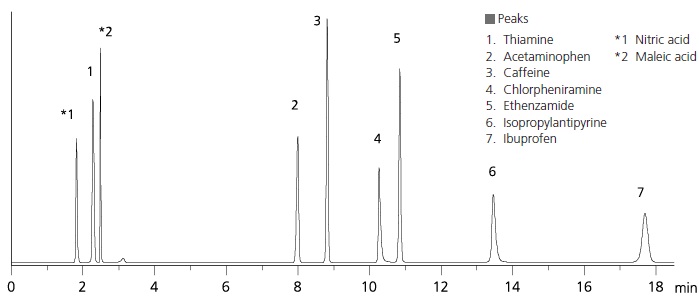Shim-pack MAqC-ODS - Features
HPLC Column
Example of Simultaneous Analysis of Water Soluble Vitamins
Water soluble vitamins contain many highly polar basic components, which are known to exhibit weak retention in the reverse-phase mode. Consequently, with typical ODS columns, such as the Shim-pack VP-ODS, an ion pair reagent is added to the mobile phase for analysis. However, using an ion pair reagent makes gradient elution difficult, resulting in peak broadening for components that take longer to elute and making it difficult to improve sensitivity. In addition, the effort required to prepare the mobile phases and condition the column is also an issue.
However, because the Shim-pack MAqC-ODS I enables using gradient elution, it can shorten analysis times and result in sharp peaks even for components that elute slowly.
For example, riboflavin, which elutes as the final peak with a typical ODS column, is detected with approx. 2.3 times higher sensitivity by the Shim-pack MAqC-ODS I.
Shim-pack MAqC-ODS I

| Column size | 150 mmL. x 4.6 mmI.D., 5 μm |
|---|---|
| Mobile phase | A) 10 mmol/L phosphate (Na) buffer solution (pH 2.6) B) Acetonitrile |
| Time program | B Conc. 1% (0 min) → 1% (2.5 min) → 50% (10 min) → 1% (10.01 min → 15 min) |
| Detection | UV 210 nm |
| Flow rate | 1.2 mL/min |
| Injection volume | 10 μL |
| Column temperature | 40 °C |
Shim-pack VP-ODS

| Column size | 150 mmL. x 4.6 mmI.D., 5 μm |
|---|---|
| Mobile phase | A) 100 mmol/L phosphate (Na) buffer solution (pH 2.1) containing 0.8 mmol/L sodium 1-octanesulfonate B) Acetonitrile A/B = 10/1 (v/v) |
| Detection | UV 210 nm |
| Flow rate | 1.2 mL/min |
| Injection volume | 10 μL |
| Column temperature | 40 °C |
Example of Analyzing Impurities in a Pharmaceutical
Many pharmaceuticals are basic compounds. The majority of impurities in pharmaceuticals, such as unreacted ingredients, by-products, and decomposition products, are highly polar basic substances. Consequently, analyzing impurity peaks using LC/MS can be difficult if a non-volatile ion pair reagent is contained.
In the following example of analyzing famotidine, using a Co-Sense for LC/MS automatic pretreatment system, to desalt the mobile phase used with the Shim-pack MAqC-ODS I column enabled analysis by LC/MS. While a typical ODS column (Shim-pack VP-ODS) detects 12 types of impurities, the Shim-pack MAqC-ODS Ⅰ detects 20 types of impurities due to separation specificity and gradient elution.
Shim-pack MAqC-ODS I

| Column size | 150 mmL. x 4.6 mmI.D., 5 μm |
|---|---|
| Mobile phase | A) 10 mmol/L phosphate (Na) buffer solution (pH 2.6) B) Acetonitrile |
| Time program | B Conc. 8% (0 min) → 8% (5 min) → 50% (12 min) → 8% (12-20 min) |
| Detection | UV 254 nm |
| Flow rate | 1.0 mL/min |
| Injection volume | 5 μL |
| Column temperature | 25 °C |
Shim-pack VP-ODS

| Column size | 150 mmL. x 4.6 mmI.D., 5 μm |
|---|---|
| Mobile phase | 2 g of sodium 1-heptanesulfonate was dissolved in 900 mL of water and acetic acid (100) was added to produce a pH of 3.0. Then water was added to make 1000 mL. 240 mL of acetonitrile and 40 mL of methanol were added to this solution. |
| Detection | UV 254 nm |
| Flow rate | 0.5 mL/min |
| Injection volume | 5 μL |
| Column temperature | 25 °C |
Example of Analyzing a Cold Remedy
Gradient elution with a Shim-pack MAqC-ODS I column was used for simultaneous analysis of components contained in an over-the-counter commercial cold remedy. The ability to use gradient elution enables the acquisition of sharp peaks, even for components that eluted slowly, similar to the water soluble vitamin and drug impurity examples above.

| Mobile phase | A) 20 mmol/L phosphate (Na) buffer solution (pH 2.5) B) Acetonitrile |
|---|---|
| Time program | B Conc.1% (0 min) → 1% (2min) → 50% (8 min) → 50% (18 min) → 1% (18.01 min → 23 min) |
| Detection | UV 220 nm |
| Flow rate | 1.0 mL/min |
| Injection volume | 10 μL |
| Column temperature | 40 °C |
For more applications, please click here.
Product Information
| Particle Size | Pressure Tolerance | Length | 4.6 mmI.D. | 2.0 mmI.D. |
| 5 μm | 20 Mpa | 150 mm | 228-59936-91 | 228-59936-94 |
Notes
To use this column efficiently:
- To increase the retention of basic compounds, please use a buffer solution within the pH 2 to 4 range.
- In the case of a basic substance tailing, it may be possible to improve the peak shape by increasing the salt concentration of a buffer solution.
- The elution of basic compounds is faster by increasing the salt concentration, and it is possible to adjust retention by salt concentration.
This product developed by collaboration with Eisai Co., Ltd.


